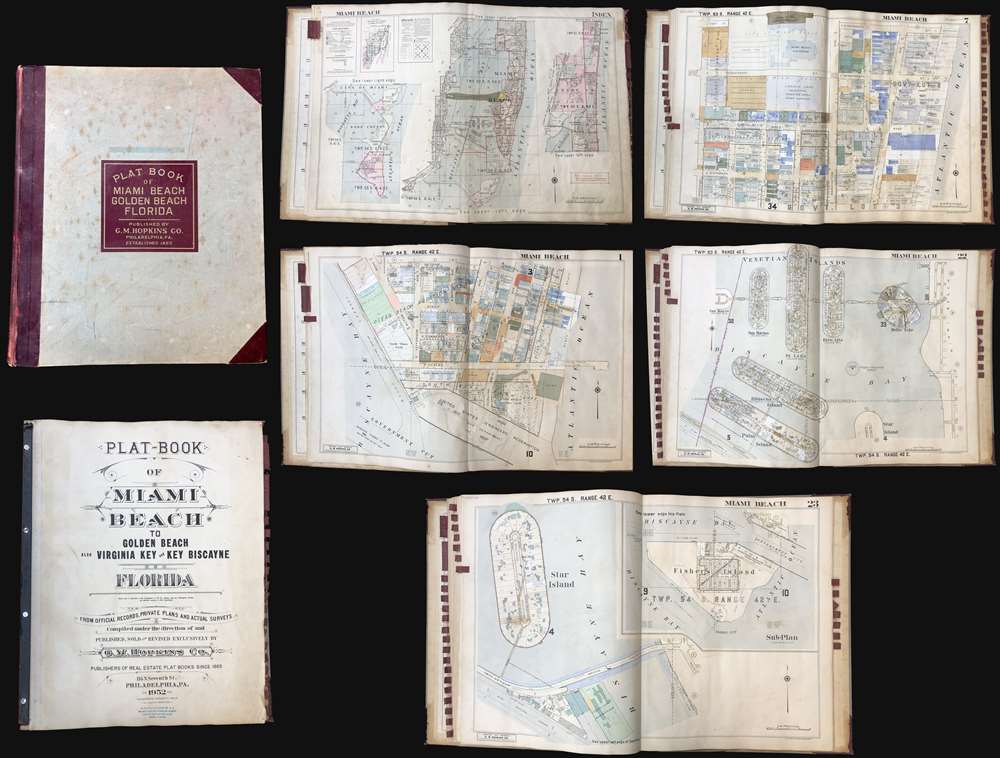This item has been sold, but you can get on the Waitlist to be notified if another example becomes available.
1952 Hopkins Plat Atlas of Miami Beach, Florida
PlatBookMiamiBeach-hopkins-1952
Title
1952 (dated) 24.5 x 19 in (62.23 x 48.26 cm)
Description
Art Deco in Miami
This atlas illustrates many of the iconic art deco buildings for which Miami Beach is most famous. Art Deco was introduced to the world at the 1925 Exposition of Modern and Decorative Arts in Paris - just before construction in Miami Beach began in earnest. Miami's famous Art Deco district was built between 1823 and 1943 and today consists of more than 960 buildings, ranging from humble apartment buildings to grandiose waterfront hotels. Prominent Miami Art Deco architects of this period include Henry Hohauser and L. Murray Dixon. The Art Deco district of Miami was in danger of being demolished in the 1960s - 1970s but local activists and preservationists saved the district, registering it in 1979 as a U.S. Historic District. Today, the beachside city glows with whimsical pastel tones, porthole windows, striking geometric forms, flora and fauna motifs, bold curves, chrome, and terrazzo floors.Plat Maps
Cadastral plat or land ownership maps grew out of the techniques developed by the Public Land Survey System (PLSS), a cartographic strategy implemented to survey the 1787 Northwest Ordinance. The PLSS allowed for the systematic surveying and mapping of territory by breaking it into an orderly grid. While initially a government mapping system, the PLSS was commercialized in the late 19th century by companies like the Sanborn Map Company and the G. M. Hopkins Company.Following on similar maps issued in London, the Sanborn Map Company, founded by Daniel Alfred Sanborn in 1866, used the PLSS system to create highly detailed and modifiable maps for the private insurance sector. Aetna Insurance Company, Sanborn's first such client, contracted the firm to prepare fire insurance maps for urbanized areas in Tennessee. Sanborn later produced similar maps of Boston and New York City. The maps tracked such factors as building height, building materials, façade materials, and proximity to other buildings, utility access, and fire departments - thus providing insurance underwriters with valuable data. The maps could easily be updated and revised as new buildings were constructed and old buildings demolished by applying paste downs over older content.
The G.M. Hopkins Company took the discipline further by also adding property ownership details and civic data. They began producing plat maps that traced property ownership, landmarks such as churches and cemeteries, roads, municipal properties, bodies of water, and much more. Hopkins maps are strikingly detailed, noting the dimensions of lots, the width of streets, and names of property owners - combining the Sanborn style insurance map with more traditional cadastral property maps. Many such maps remain in use today to determine lots, easements, zoning compliance, legal issues, and other land use questions.
Publication History and Census
This atlas was created and published in Philadelphia in 1952 by the G.M. Hopkins Company. While we are unaware of its full provenance, it bears a stamp of D. Earl Wilson, an important figure in Miami real estate from the 1930s. Unlike comparable atlases by Sanborn, which are reasonably common, this Hopkins Miami Beach atlas is exceedingly rare. The OCLC records only two other known examples at the Library of Congress and the University of Miami.Cartographer
G. M. Hopkins Company (Griffith M. Hopkins; 1865 - 1940, 1943 - today) was an American civil engineering and surveying firm based in Philadelphia. Founded in Philadelphia in 1865 by brothers Griffith Morgan Hopkins (1834 - 1901) and Henry W. Hopkins (1838 - 1920) as G.M. Hopkins and Company, the firm focused primarily on real estate plat maps of the Eastern seaboard. The firm published 175 plat map atlases depicting cities, counties, and townships in 18 states and the District of Columbia and was among the first to create a cadastral atlas. Henry Hopkins supervised much of the surveying work. G.M. retired in 1900 (and died the following year), which allowed Henry to take control of the business, which he renamed the G.M. Hopkins Company in 1902. Henry retired in 1902 and sold the business to George B. C. Thomas, who had been working for the firm since 1896 as an engraver. The G. M. Hopkins Company was purchased by the Franklin Survey Company of Philadelphia in 1943, which continued publishing atlases under the Hopkins imprint. In 1986, the company was renamed Franklin Maps and is still in operation today. More by this mapmaker...

